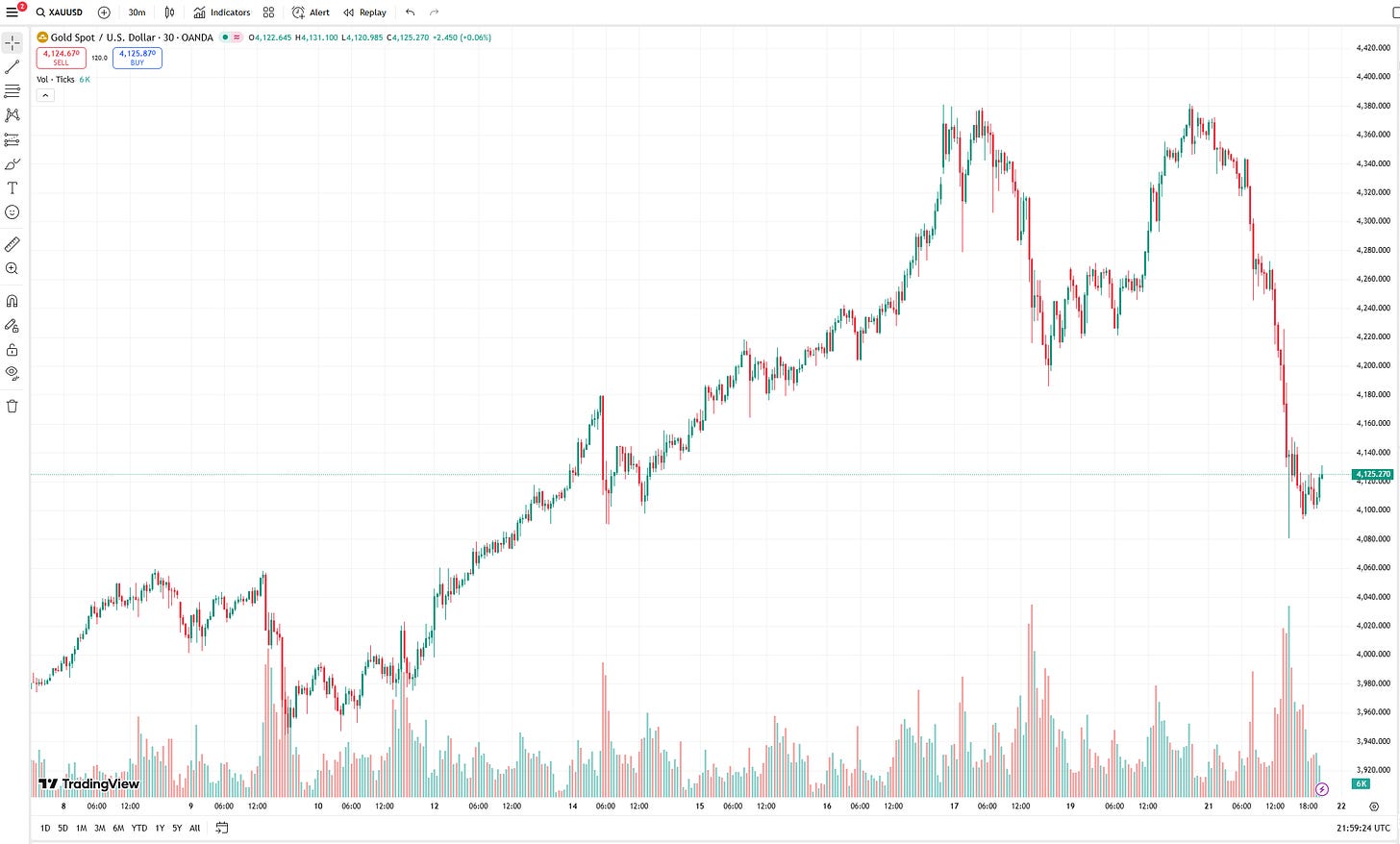Gold Is Now a Meme?
The world’s oldest store of value is behaving like GameStop — and that should make you pay attention.
For a metal that spent centuries symbolizing stability, the day’s trading looked more like a meme-stock implosion than a safe-haven correction.
If you’ve been watching gold this week, you’ve seen something that shouldn’t happen. On October 21, 2025, during U.S. trading hours, gold collapsed from $4,378 to $4,093 per ounce in under eight hours — a move of nearly 6½ percent. No wars. No inflation shocks. No central bank announcements. Just boom.
Billions in notional value vanished, and before Asia even opened, the world’s “safe haven” looked more like a meme stock caught in a short squeeze.
👉 Read the full analysis here →
The Casino Behind the Gold Price
Gleaming in the vault, gold is calm, ancient, steady but, on screen, it’s a casino. Every day, billions of dollars’ worth of “gold” are traded that don’t actually exist: futures, ETFs, swaps, and leveraged positions that never touch a single bar of real metal.
This “paper gold” system, born out of convenience in the 1970s, now drives nearly all visible price discovery. The trouble is, the real gold market, the slow-moving physical trade of bars and bullion, operates on entirely different logic.
Asian central banks buy gold methodically to de-dollarize reserves. But it’s the Western paper market that sets the “spot” price, often in the opposite direction.
That’s why we’re seeing these bizarre daily moves. During Asian hours, prices rise with steady physical demand. During New York hours, they crash as leveraged traders unwind.
The Disconnect Is Growing
This isn’t a conspiracy theory — it’s just market structure.
The COMEX and London OTC markets together handle hundreds of millions of ounces of synthetic gold contracts daily. In contrast, physical delivery from those systems is in the range of 2–3 tonnes a day, a rounding error in global terms.
The result? Price signals that often have nothing to do with real supply or demand.
Central banks don’t care. They’re buying quietly, diversifying away from U.S. Treasuries, building reserves they can hold at home, and hedging against financial sanctions risk. That’s what the Bundesbank, Netherlands, and Poland have already done. It’s what China, India, and Turkey are doing now.
“If it’s not in our vault, it’s not really ours.”
— A European central banker, 2023
Why This Matters for Investors
Volatility like this is a symptom of two gold markets diverging: one financial and leveraged, one monetary and physical. The financial market trades momentum, algorithms, and margin calls. The monetary market trades sovereignty, confidence, and time.
If you’re holding gold as insurance, the day-to-day chaos doesn’t matter. But if you’re trying to trade the noise, you’re not in a vault, you’re in Vegas.
The Takeaway
Gold’s wild behavior isn’t proof that it’s broken. It is proof that the global financial system is. The noise of the paper market is masking a far bigger signal:
a slow, global re-anchoring of trust toward tangible, self-custodied assets.
That’s the real story behind the October 2025 price shock, and it may be just beginning.
This longform explainer breaks down:
how “paper gold” markets distort real-world prices,
why central banks are moving gold home,
the quiet eastward migration of physical bullion, and
why the world’s oldest monetary asset may soon define a new financial era
💬 If you found this useful, share it — or subscribe to Capital in Transition to follow the great monetary realignment as it unfolds.
“Investing in a rapidly changing world order.”
— capitalintransition.com


